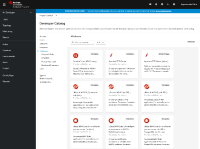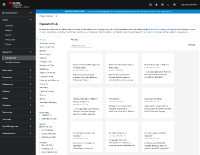-
Feature
-
Resolution: Unresolved
-
Normal
-
None
-
None
-
None
-
None
-
Product / Portfolio Work
-
False
-
False
-
?
-
No
-
?
-
?
-
?
Epic Goal
- Give customers clear indication whether or not certain content shipped by default in their OpenShift clusters requires additional subscriptions beyond the OpenShift subscription
Why is this important?
- OpenShift ships with numerous content types out of the box on every cluster: sample image streams, templates, optional OLM-managed operators
- the above content is always made available by default, regardless of whether the customer actually bought OKE, OCP or OPP
- it is difficult for a customer to discern whether something ships as free-to-user or actually requires an additional subscription
- Example in attached screenshots:
- several standard image streams available in the developer console promotes usage of paid products without hints that these actually require a separate subscription (3scale & other middleware products in this case)
- several Red Hat operators are available to install despite they require additional subscriptions but there is no hint about that in the UI
Scenarios
- The sample templates catalog in the developer console should display badges that denote additional subscription requirements for the content referenced (image streams, helm charts, operators)
- The OperatorHub catalog view in the administrator console should display badges that denote additional subscription requirements for software managed / provided by the operator
- The OperatorHub catalog view in the administrator console should allow to filter which operators are covered by an OKE subscription vs. a OCP subscription, so that customers can filter for offerings included in their subscription
Acceptance Criteria
- all Red Hat supplied images streams carry information about additional subscriptions if they are required unless they are free to use
- all Red Hat provided optional operators (via OperatorHub) carry information about additional subscription requirements unless they are free to use (except operator entitlement via OKE)
- all ISV supplied optional operators and helm chart carry information about additional subscription requirements
Dependencies (internal and external)
- Sample Images carry/publish metadata that denotes additional subscription requirements as part of their release process
- Red Hat operators carry/publish metadata that denotes additional subscription requirements as part of their release process
- COMET support for maintaining metadata about subscription requirements
Previous Work (Optional):
Open questions::
- …
Done Checklist
- CI - CI is running, tests are automated and merged.
- Release Enablement <link to Feature Enablement Presentation>
- DEV - Upstream code and tests merged: <link to meaningful PR or GitHub Issue>
- DEV - Upstream documentation merged: <link to meaningful PR or GitHub Issue>
- DEV - Downstream build attached to advisory: <link to errata>
- QE - Test plans in Polarion: <link or reference to Polarion>
- QE - Automated tests merged: <link or reference to automated tests>
- DOC - Downstream documentation merged: <link to meaningful PR>
- is incorporated by
-
CONSOLE-3010 OperatorHub displays subscription requirements of operators
-
- Closed
-
- links to

